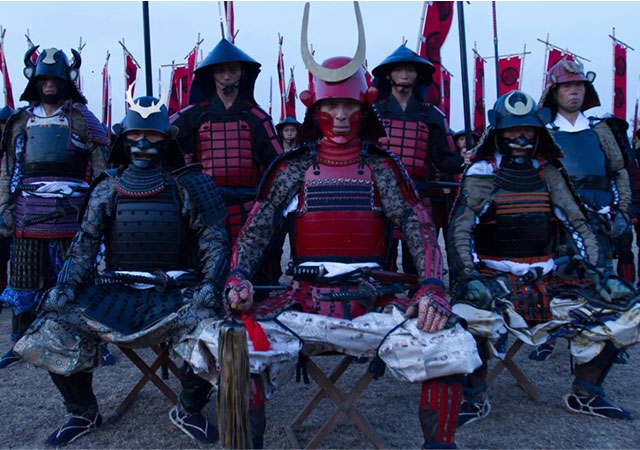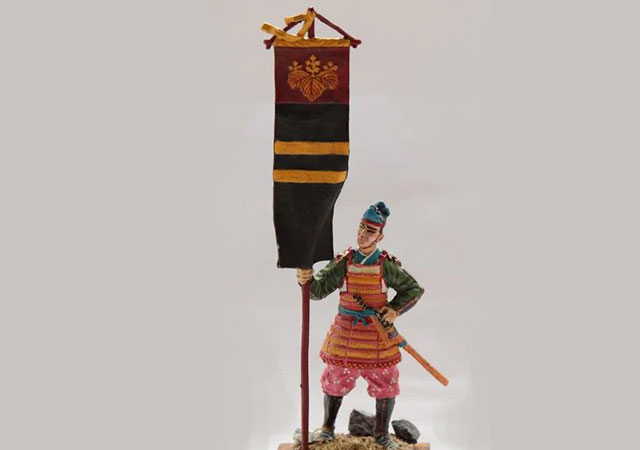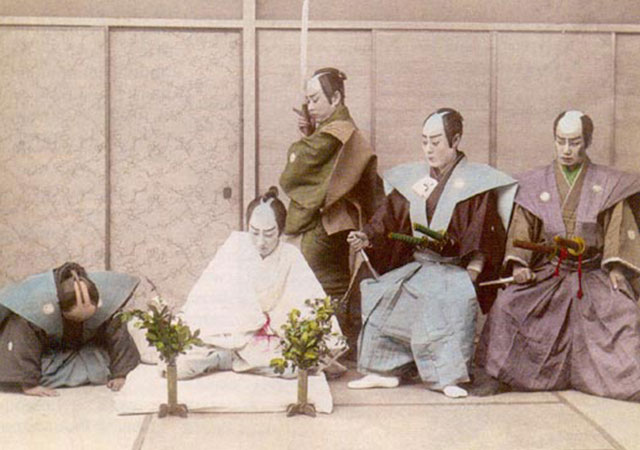
In 1603, the head of the Tokugawa Clan proclaimed himself shogun, thus starting the rule of the clan in Japan. Having set up a complete military dictatorship of the samurai by the 17th century, the Tokugawa Clan managed to completely centralize and augment its authority.
The Tokugawa’s strong central authority put an end to feudal fragmentation and resulted in the minimization of wars between feudal lords. Now, samurai served only to put down peasant and civilian revolts.
As for the samurai’s social status, by then, they were at the top since the shogunate closely monitored the estate system of power and subordination. The following hierarchy system was developed: samurai – peasants – artisans – merchants. Of course, the samurai ranked the highest as they were a support of the Tokugawa regime and were considered the core of the nation and the best people. There was a separate group of court aristocracy. Even though officially, it ranked above samurai, in fact, it was deprived of any political and economic power.
Although the samurai estate was considered single on paper, the Tokugawa regime clearly divided the samurai by their ranks. In addition to the gokenin, the existing samurai of the highest military nobility, feudal lords whose status depended on the size of their lands, a new samurai class of hatamoto was established. Hatamoto, translated from Japanese, means the standard-bearer, and this class of samurai was directly subordinate to the military government and the shogun.

The hatamoto samurai had the powers that the gokenin did not have. They had the right to a private audience with the shogun and could enter the building from the main entrance. In the event of war, the hatamotos formed the shogun’s army and were part of the shogun’s administration. According to the social hierarchy, the hatamoto and gokenin samurai were followed by baishin (a vassal of vassal), and the lowest samurai estate was ashigaru, ordinary soldiers.
Separately from the samurai estates, there were ronin. Ronin is a samurai who has let his master die or has been cast out from the clan or has left the suzerain voluntarily, for example, for a blood feud, and could return to service after. Many ronin who were unwilling or unable to be engaged in farming, handicrafts or trade, since they had no livelihood, gathered in gangs and robbed small villages or bystanders on the road. Ronin often became hired killers who would stop at nothing for money.
By the 17th century, the number of samurai reached approximately 400,000 and about two million together with their families. Japan’s population itself at that time was about 16 million.
The number of samurai varied by region, depending on the wealth and the size of the lands of the feudal lords. This means that the richer the feudal lords in a particular province are, the more samurai lived there.
The majority of the samurai did not own lands and were rewarded rice for serving. The unit of measurement of this payment was koku, rice ration. The extent of the payment depended, of course, on the samurai status. With the received rice, the samurai could keep their families, buy clothes, household items, etc. In fact, it was the only source of income since the Tokugawa shogunate prohibited samurai to be engaged in crafts, trade, and usury, considering it shameful for them. However, the samurai were exempt from taxes.
As for the samurai’s conduct during the Tokugawa shogunate’s rule, they were to be guided by the “Buke hatto” code written by Tokugawa Ieyasu in 1615. The code listed the rules of samurai’s conduct on service and at home, how samurai must treat their weapons, serve the feudal lords and address the feudal lords whom they serve, what clothes must be worn by each samurai class, what literature they must read, and it also explained marriage matters.

In addition to the rules and duties, the Buke hatto strictly protected the samurai’s honor. One of the articles of the code stated that a samurai could kill a peasant or citizen on the spot if they insulted him. Peasants, once they notice a samurai, had also to take off their hats and go on their knees, no matter where they were – on the roadside or at work. Every such meeting with a samurai could have ended in death for a peasant. A peasant or citizen could also be punished for that a samurai could consider it excessive. However, a samurai could also be punished by death for violations that would have not resulted in death for a peasant. For example, for disobeying an order or breaking their promises, samurai had to commit hara-kiri.

The reign of the Takugawa Family was a period of supreme development for samurai. During this period, the samurai’s culture, customs and rules were fully developed.
See also
-
Tomoe Gozen

Gozen is regarded as one of the few historically documented examples of true female warriors of feudal Japan, known as onna-musha or onna-bugeisha. Although Japanese history records countless women who at various times were forced to take up arms—for example, in defense of their castles—Tomoe Gozen was, without any doubt, a genuinely skilled and accomplished fighter. She was the wife of Kiso (Minamoto) Yoshinaka, although The Tale of the Heike describes her more as a female vassal. Yoshinaka rose in rebellion against the Taira clan and, in 1184, captured Kyoto after his victory at the Battle of Kurikawa. After the Taira were driven into the western provinces, Yoshinaka began insistently asserting that he alone was worthy of assuming leadership of the Minamoto clan and taking on the mantle of its head.
-
Tachibana Muneshige

Tachibana Muneshige was born the eldest son of Takahashi Shigetane, one of the principal retainers of the Ōtomo clan and commander of Iwaya Castle. In childhood, he bore the name Senkumamaru. His early years coincided with a period of intense military confrontation between the Ōtomo clan and other powerful warrior houses of Kyūshū—namely the Shimazu, Akizuki, and Ryūzōji clans.
-
Tachibana Dosetsu

Tachibana Dōsetsu is the name by which Hetsugi Akitsura is more widely known; the name of this lineage is also found read as Hekki or Bekki. For a long period, Akitsura served the Ōtomo clan, the daimyō of Bungo Province, and took part in wars against the Ōuchi family, the principal enemies of the Ōtomo in northwestern Kyushu. In the 1560s, Akitsura seized the castle of the Tachibana clan, which had rebelled against the Ōtomo, and thereafter adopted the surname Tachibana. Around the same time, he took Buddhist vows and assumed the name Dōsetsu, which means “Snowy Road.”
-
Taira no Masakado

Taira no Masakado embodied the quintessential samurai of his era—self-assured, harsh, and unyielding. In his youth, he served in the palace guard and repeatedly proved his bravery while suppressing unrest. Thanks to these achievements, Masakado sought the post of chief of the capital’s military-police office (the kebiishi-chō), but he was rejected: by that time, nearly all court positions—now little more than privileged sinecures—were controlled by members of the powerful Fujiwara clan.
-
Sakakibara Yasumasa

Yasumasa was the second son of Sakakibara Nagamasa and was born in Ueno in Mikawa Province. From a young age, he began serving Tokugawa Ieyasu and eventually rose to the position of one of his most trusted generals. His wife was the daughter of Osuga Yasutaka. Ieyasu first noticed the young Yasumasa during the suppression of the Ikkō-ikki uprising in Mikawa in 1564. Thanks to his demonstrated abilities, Yasumasa was granted the privilege of using the character “yasu”—the second character of Ieyasu’s own name—in his own. Although he was the second child in his family, he became his father’s heir, though the exact reasons for this remain unknown.
-
Sakai Tadatsugu

Tadatsugu was one of the most renowned generals serving Tokugawa Ieyasu. After Ieyasu broke ties with the Imagawa clan, Tadatsugu—an ardent supporter of this decision—was granted command of Yoshida Castle in 1565, which controlled the coastal road from Tōtomi to Mikawa. During the Battle of Mikatagahara in 1573, he held the right flank of the Tokugawa forces even when the troops sent by Oda fled under the assault of the Takeda army. In the Battle of Nagashino in 1575, he personally requested permission to carry out a night attack on the Takeda camp, which he executed brilliantly together with Kanamori Nagachika.
-
Ryuzoji Takanobu

Takanobu was the eldest son of Ryūzōji Takaie and the great-grandson of Ryūzōji Iekane. His father was killed by a man named Baba Yoritiku in 1544. At a young age, Takanobu took Buddhist vows and received the monastic name Engetsu. However, around the age of eighteen, he returned to secular life, and in 1548, after the death of Ryūzōji Tanehide, he became the head of both branches of the Ryūzōji family.
-
Ouchi Yoshihiro

Ōuchi Yoshihiro was the second son of Ōuchi Hiroyo, who headed the Ōuchi clan in the western part of Honshu. In 1363, Shogun Ashikaga Yoshimitsu confirmed the Ōuchi family in the position of shugo of Suō and Nagato Provinces. In his youth, Yoshihiro assisted his father in strengthening the influence of the Northern Court on the island of Kyushu — they served under Imagawa Ryōsun, who had been tasked with subjugating the nine provinces of Kyushu.

